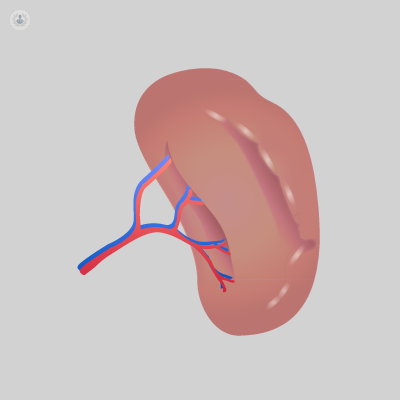Spleen removal
Mr Eriberto Farinella - Surgery
Created on: 11-13-2012
Updated on: 03-29-2023
Edited by: Aoife Maguire
What does the spleen do?
The spleen is a small, fist-sized organ that’s filled with blood. It’s delicate and located underneath the left rib cage, close to the stomach.
The spleen is a key component of the immune system as it contains white blood cells that kill bacteria and fight infections, called macrophages.
The spleen also filters out old red blood cells from the bloodstream.
What is spleen removal surgery?
Spleen removal surgery is called a partial splenectomy if just part of the spleen is removed, or a splenectomy if the whole spleen is removed.

Why would you need spleen removal surgery?
The reasons you might need a splenectomy include:
- A ruptured spleen could be caused by injury and can lead to internal bleeding which could be life-threatening. This is the most common reason for the spleen to be removed.
- An enlarged spleen, if causing pain, can be treated by removal. Usually, removal isn’t a first-line treatment but an enlarged spleen is more prone to rupture.
- Cancer involving the spleen or cancers that affect the blood cells, such as leukaemia or lymphoma, will likely result in the spleen needing to be removed.
- Rare blood disorders, such as sickle cell anaemia or haemolytic anaemia, may be treated by removing the spleen if other options have been exhausted.
- If an infection around the spleen does not clear up with other treatments, then a splenectomy will be recommended.
What are the signs of a spleen problem?
Symptoms that can be experienced if there is a problem with the spleen include:
- pain behind the left ribs that is tender to touch
- feeling full quickly
- anaemia
- fatigue
- dizziness
- rapid heart rate
- frequent infections
- bleeding easily
How are spleen problems diagnosed?
The shape and size of the spleen can help to determine the cause of the issues, for which ultrasound scans, CT scans, MRI scans, and occasionally a nuclear scan may be performed. If the spleen is enlarged, it may be detected by a physical exam.
The amount, shape, and size of the cells that make up the blood can also help indicate the cause of spleen issues, so blood tests and complete blood count (CBC) might be performed.
How is the spleen removed?
Splenectomies can either be performed laparoscopically (keyhole surgery) or as open surgery. Most arfore carried out laparoscopically. The most important determining factor is the size of the spleen; if it is too large for laparoscopic surgery then open surgery will be chosen.
During a laparoscopic splenectomy, a special instrument guided by a camera is inserted via small incisions and allows the surgeon to access the abdomen and spleen without the need to make large cuts and scars.
A general anaesthetic is still required for this type of splenectomy. The benefits of laparoscopic surgery include less pain, less time spent in the hospital, and a quicker return to normal life following the procedure.
Open surgery involves a large cut being made in the abdomen, to allow the extraction of the spleen. Open surgery is usually chosen if the spleen is very damaged or large and will often be done in an emergency case. General anaesthetic is also required.
Throughout the surgery, the surgical team will keep an eye on the patient’s heart rate, blood pressure and blood oxygen levels.

How can you prepare for a splenectomy?
Prior to any splenectomy, the risks and benefits will be weighed up and considered to ensure the patient is a suitable candidate for the procedure. Depending on their age and overall health, blood tests, chest x-rays and ECG might be done.
The removal of the spleen is major surgery and can greatly compromise the immune system. For that reason, vaccines will be administrated against bacterial and viral infections to help boost the immune system in preparation. Similarly, blood transfusions may be given to make sure there are enough platelets and red blood cells in the blood.
You may be advised to stop taking certain medications a few days before the surgery. Fasting and not drinking any fluids the night before the procedure is also necessary.
What happens after a splenectomy?
After a laparoscopic splenectomy, the small incisions are either stitched together or glued. Often patients are able to leave the same day or the following day. If the patient does return the same day, it is necessary for them to be accompanied by a family member or friend.
After an open surgery splenectomy, it will be necessary to stay in hospital for two to six days. It is normal to feel some pain, which can be managed with painkillers. During the hospital stay, you will be given some exercises to keep moving, to avoid blood clots. Full recovery generally depends on why the spleen was removed in the first place, which takes between four and six weeks in most cases.
What complications following splenectomy can occur?
Like most surgeries, the potential complications that can arise after a splenectomy include post-operative bleeding, reaction to the anaesthesia, and damage to the nearby abdominal organs. The biggest risk, however, is the heightened risk of infection. Both laparoscopic and open splenectomies carry risks and they may include:
- blood clots forming in the main vein of the liver
- hernia at site of the incision
- pus collecting under the diaphragm
Can you live without a spleen?
Following the removal of the spleen, the liver will assume many of its functions, so it is possible to live without a spleen. The spleen, however, plays a vital role in the immune system. By removing the spleen, the risk of infection increases. The prognosis depends on the patient’s health and well-being.
What are the long-term effects of a splenectomy?
Due to the risk of the infection because of a weakened immune system, vaccinations, against pneumonia for example, booster shots, and yearly flu vaccinations are necessary to protect against infectious bacteria and viruses.
Prophylactic (preventative) antibiotics may be required for the rest of your life. You need to be aware of the first signs of infection and contact your GP immediately to get antibiotics. If an infection worsens, you may need to stay in hospital so the condition can be monitored.
Can your spleen grow back after being removed?
Some organs, such as the liver, can regenerate or grow back following removal. The spleen, however, can’t. Strangely, spleens can sometimes duplicate themselves, if some of their cells break away from the spleen and end up somewhere with many blood vessels. These are called accessory spleens but their capacity to function as a replacement spleen is yet unproven.


